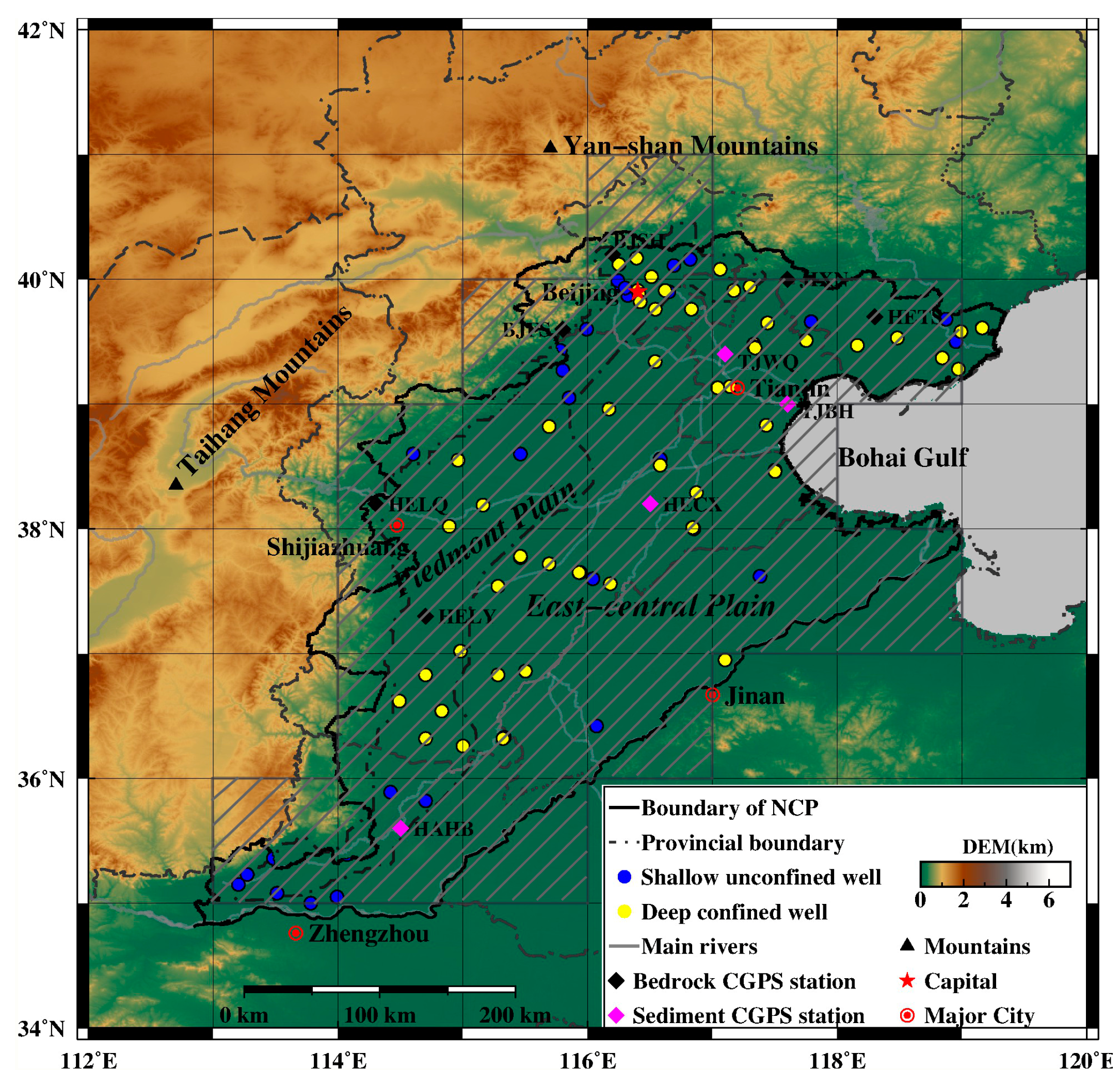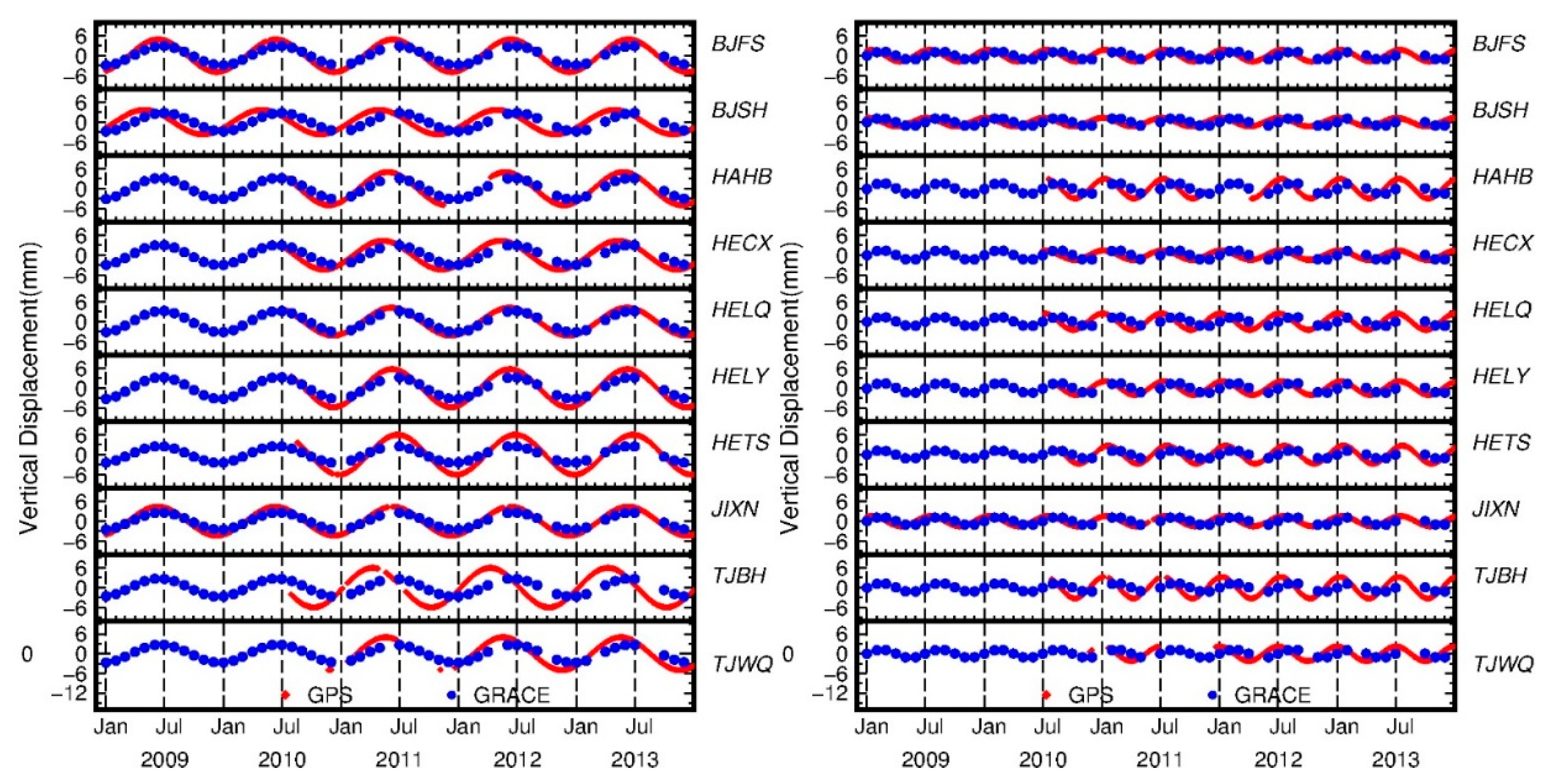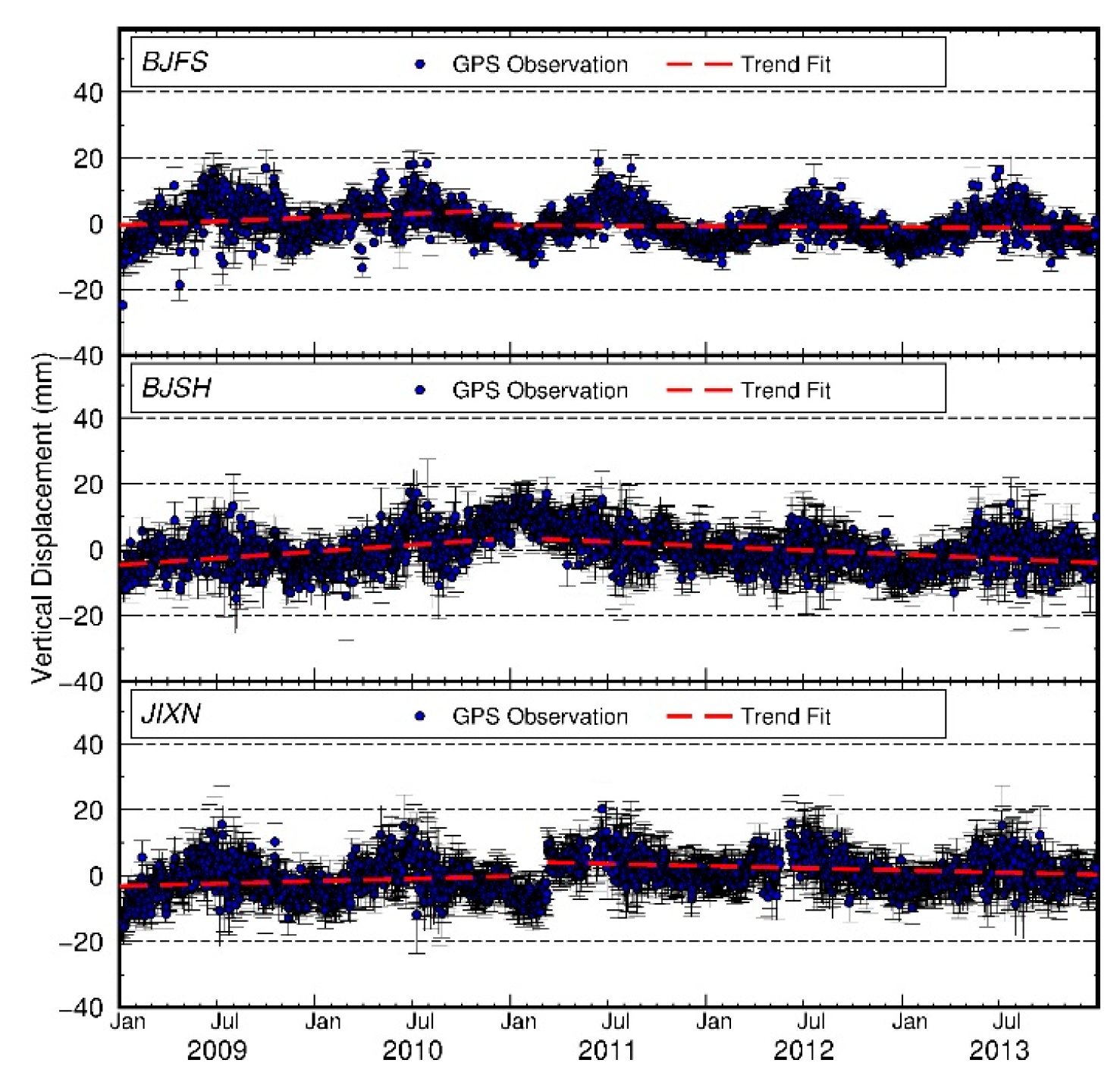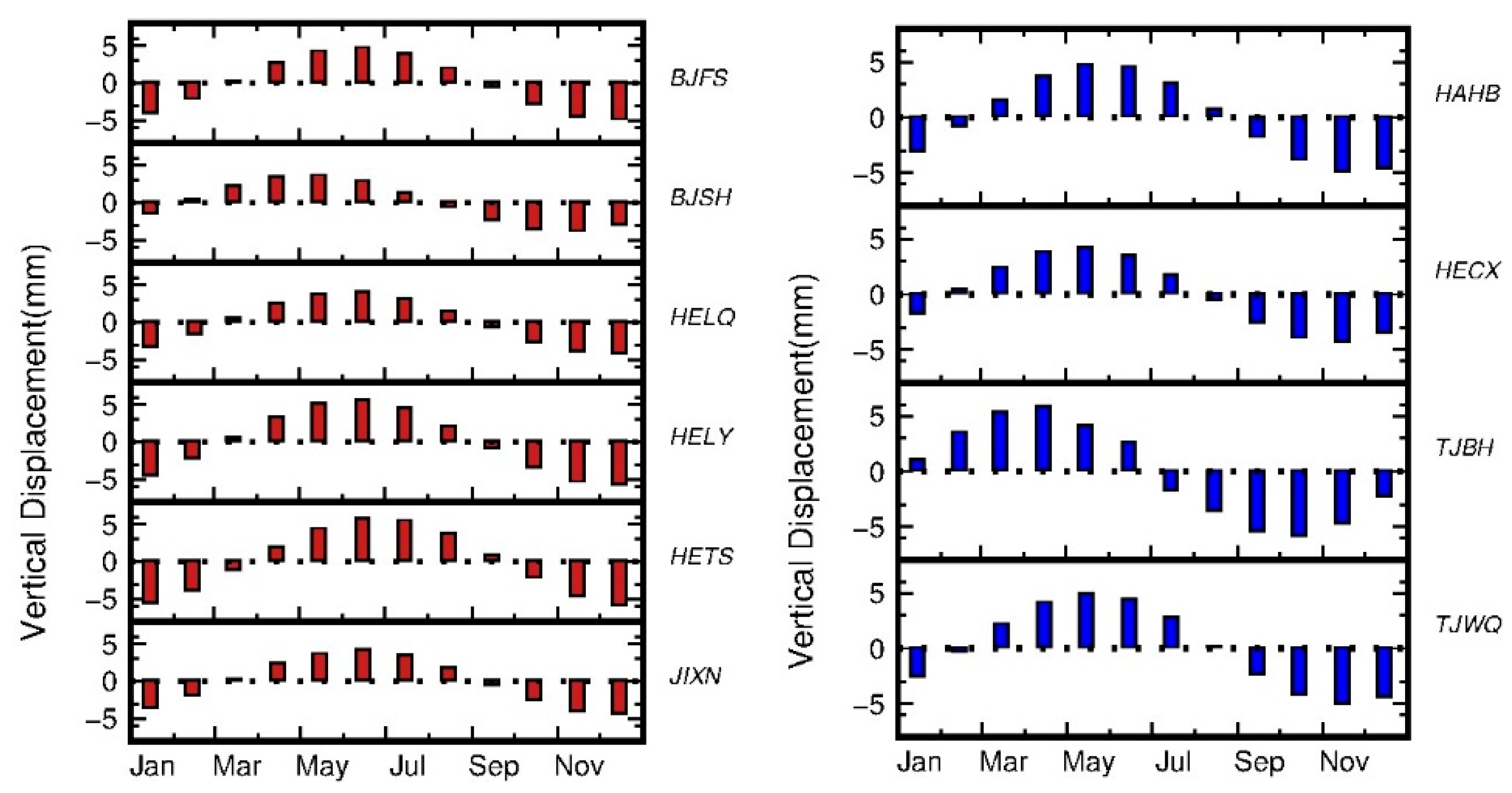Vertical Displacements Driven by Groundwater Storage Changes in the North China Plain Detected by GPS Observations
Abstract
1. Introduction
2. Data and Methods
2.1. GPS Data
2.2. TWS and GWS Variations Derived from GRACE
2.3. In Situ Groundwater LEVEL MEASUREMENTS
3. Results and Discussion
3.1. Seasonal and Secular Signals Revealed by GPS and GRACE
3.2. Impacts of Bedrock and Sediment Basement to GPS Results
3.3. Characteristics of Shallow and Deep Groundwater Changes in NCP
4. Conclusions
Acknowledgments
Author Contributions
Conflicts of Interest
References
- China Water Resources Bulletin. Ministry of Water Resources of China (MWR), Beijing. Available online: http://www.mwr.gov.cn/sj/tjgb/szygb/ (accessed on 19 December 2017).
- Zheng, C.; Liu, J.; Cao, G.; Kendy, E.; Wang, H.; Jia, Y. Can China Cope with Its Water Crissis?-Perspective from the North China Plain. Ground Water 2010, 48, 350–354. [Google Scholar] [CrossRef] [PubMed]
- Moiwo, J.P.; Tao, F.; Lu, W. Analysis of satellite-based and in situ hydro-climatic data depicts water storage depletion in North China Region. Hydrol. Process. 2013, 27, 1011–1020. [Google Scholar] [CrossRef]
- Feng, W.; Zhong, M.; Lemoine, J.M.; Biancale, R.; Hsu, H.T.; Xia, J. Evaluation of groundwater depletion in North China using the Gravity Recovery and Climate Experiment (GRACE) data and ground-based measurements. Water Resour. Res. 2013, 49, 2110–2118. [Google Scholar] [CrossRef]
- Tang, Q.; Zhang, X.; Tang, Y. Anthropogenic impacts on mass change in North China. Geophys. Res. Lett. 2013, 40, 3924–3928. [Google Scholar] [CrossRef]
- Jin, S.G.; Feng, G.P. Large-scale variations of global groundwater from satellite gravimetry and hydrological models, 2002–2012. Glob. Planet. Chang. 2013, 106, 20–30. [Google Scholar] [CrossRef]
- Farrell, W.E. Deformation of the Earth by surface loads. Rev. Geophys. 1972, 10, 761–797. [Google Scholar] [CrossRef]
- Becker, J.M.; Bevis, M. Love’s problem. Geophys. J. Int. 2004, 156, 171–178. [Google Scholar] [CrossRef]
- Tsai, V.C. A model for seasonal changes in GPS positions and seismic wave speed due to thermoelastic and hydrologic variations. J. Geophys. Res. 2011, 116. [Google Scholar] [CrossRef]
- Wang, T.; Zhou, W.; Chen, J.; Xiao, X.; Li, Y.; Zhao, X. Simulation of hydraulic fracturing using particle flow method and application in a coal mine. Int. J. Coal Geol. 2014, 121, 1–13. [Google Scholar] [CrossRef]
- Wang, T.; Hu, W.; Elsworth, D.; Zhou, W.; Zhou, W.; Zhao, X.; Zhao, L. The effect of natural fractures on hydraulic fracturing propagation in coal seams. J. Pet. Sci. Eng. 2017, 150, 180–190. [Google Scholar] [CrossRef]
- Davis, J.L.; Elósegui, P.; Mitrovica, J.X.; Tamisiea, M.E. Climate-driven deformation of the solid Earth from GRACE and GPS. Geophys. Res. Lett. 2004, 31. [Google Scholar] [CrossRef]
- Van Dam, T.; Wahr, J.; Lavallée, D. A comparison of annual vertical crustal displacements from GPS and Gravity Recovery and Climate Experiment (GRACE) over Europe. J. Geophys. Res. 2007, 112. [Google Scholar] [CrossRef]
- Fu, Y.; Freymueller, J. Seasonal and long-term vertical deformation in the Nepal Himalaya constrained by GPS and GRACE measurements. J. Geophys. Res. 2012, 117. [Google Scholar] [CrossRef]
- Zou, R.; Wang, Q.; Freymueller, J.; Poutanen, M.; Cao, X.L.; Zhang, C.H.; Yang, S.M.; He, P. Seasonal hydrological loading in southern Tibet detected by joint analysis of GPS and GRACE. Sensors 2015, 15, 30525–30538. [Google Scholar] [CrossRef] [PubMed]
- Liu, R.L.; Li, J.C.; Fok, H.S.; Shum, C.K.; Li, Z. Earth Surface Deformation in the North China Plain Detected by Joint Analysis of GRACE and GPS Data. Sensors 2014, 14, 19861–19876. [Google Scholar] [CrossRef] [PubMed]
- Wang, L.; Chen, C.; Du, J.; Wang, T. Detecting seasonal and long-term vertical displacement in the North China Plain using GRACE and GPS. Hydrol. Earth Syst. Sci. 2017, 21, 2905–2922. [Google Scholar] [CrossRef]
- Wu, C.; Xu, Q.; Zhang, X.; Ma, Y.H. Palaeochannels on the North China Plain: Types and distributions. Geomorphology 1996, 18, 5–14. [Google Scholar] [CrossRef]
- Wang, G. Groundwater System in Northern China; Geological House: Beijing, China, 2010. [Google Scholar]
- Yu, S.B.; Kuo, L.C.; Punongbayan, R.S.; Ramos, E.G. GPS observation of crustal deformation in the Taiwan-Luzon region. Geophys. Res. Lett. 1999, 26, 923–926. [Google Scholar] [CrossRef]
- Dabove, P.; Manzino, A.M.; Taglioretti, C. GNSS network products for post-processing positioning: Limitations and peculiarities. Appl. Geomat. 2014, 6, 27–36. [Google Scholar] [CrossRef]
- Li, Q.; You, X.Z.; Yang, S.M. A precise velocity field of tectonic deformation in China as inferred from intensive GPS observations. Sci. China Earth Sci. 2012, 55, 695–698. (In Chinese) [Google Scholar] [CrossRef]
- Herring, T.A.; King, R.W.; McClusky, S.C. Introduction to GAMIT/GLOBK; 2015, MIT. Available online: http://www-gpsg.mit.edu/~simon/gtgk/docs.htm (accessed on 19 December 2017).
- Gérard, P.; Brian, L. IERS Conventions (IERS Technical Note; 36), Frankfurt am Main: Verlag des Bundesamts für Kartographie und Geodäsie. 2010. Available online: https://www.iers.org/IERS/EN/Publications/TechnicalNotes/TechnicalNotes.html (accessed on 19 December 2017).
- Schmid, R.; Dach, R.; Collilieux, X.; Jäggi, A.; Schmitz, M.; Dilssner, F. Absolute IGS antenna phase center model igs08.atx: Status and potential improvements. J. Geodesy 2016, 90, 343–364. [Google Scholar] [CrossRef]
- Böhm, J.; Niell, A.; Tregoning, P.; Schuh, H. Global Mapping Function (GMF): A new empirical mapping function based on numerical weather data. Geophys. Res. Lett. 2006, 33. [Google Scholar] [CrossRef]
- Altamimi, Z.; Collilieux, X.; Métivier, L. ITRF2008: An improved solution of the international terrestrial reference frame. J. Geodesy 2011, 85, 457–473. [Google Scholar] [CrossRef]
- Barzaghi, R.; Carrion, D.; Pepe, M.; Prezioso, G. Computing the Deflection of the Vertical for Improving Aerial Surveys: A Comparison between EGM2008 and ITALGEO05 Estimates. Sensors 2016, 16, 1168. [Google Scholar] [CrossRef] [PubMed]
- Lemoine, J.M.; Bruinsma, S.; Loyer, S.; Biancale, R.; Marty, J.C.; Perosanz, F.; Balmino, G. Temporal gravity field models inferred from GRACE data. Adv. Space Res. 2007, 39, 1620–1629. [Google Scholar] [CrossRef]
- Wahr, J.; Molenaar, M.; Bryan, F. Time variability of the Earth’s gravity field: Hydrological and oceanic effects and their possible detection using GRACE. J. Geophys. Res. 1998, 103, 30205–30229. [Google Scholar] [CrossRef]
- Kusche, J.; Schrama, E. Surface mass redistribution inversion from global GPS deformation and Gravity Recovery and Climate Experiment (GRACE) gravity data. J. Geophys. Res. 2005, 110. [Google Scholar] [CrossRef]
- Cheng, M.; Tapley, B.D. Variations in the Earth’s oblateness during the past 28 years. J. Geophys. Res. 2004, 109. [Google Scholar] [CrossRef]
- Swenson, S.; Chambers, D.; Wahr, J. Estimating geocenter variations from a combination of GRACE and ocean model output. J. Geophys. Res. 2008, 113. [Google Scholar] [CrossRef]
- Chen, J.L.; Wilson, C.R.; Tapley, B.D.; Grand, S. GRACE detects coseismic and postseismic deformation from the Sumatra-Andaman earthquake. Geophys. Res. Lett. 2007, 34. [Google Scholar] [CrossRef]
- Rodell, M.; Houser, P.R.; Jambor, U.; Gottschalck, J.; Mitchell, K.; Meng, C.J.; Arsenault, K.; Cosgrove, B.; Radakovich, J.; Bosilovich, M. The global land data assimilation system. Bull. Am. Meteorol. Soc. 2004, 85, 381–394. [Google Scholar] [CrossRef]
- Landerer, F.; Swenson, S. Accuracy of scaled GRACE terrestrial water storage estimates. Water Resour. Res. 2012, 48. [Google Scholar] [CrossRef]
- Zhang, M.J.; Fei, Y.H. Atlas of Groundwater Sustainable Utilization in North China Plain; China Cartographic Publishing House: Beijing, China, 2009. [Google Scholar]
- Nikolaidis, R. Observation of Geodetic and Seismic Deformation with the Global Positioning System. Ph.D. Thesis, University of California San Deigo, San Deigo, CA, USA, 2002; pp. 1–115. [Google Scholar]
- Cao, G.; Zheng, C.; Scanlon, B.R.; Liu, J.; Li, W. Use of flow modeling to assess sustainability of groundwater resources in the North China Plain. Water Resour. Res. 2013, 49, 159–175. [Google Scholar] [CrossRef]
- Hu, X.; Shi, L.; Zeng, J. Estimation of actual irrigation amount and its impact on groundwater depletion: A case study in the Hebei Plain, China. J. Hydrol. 2016, 543, 433–449. [Google Scholar] [CrossRef]
- Tan, X. The Study of Groundwater Recharge in North China Plain. Ph.D. Thesis, Wuhan University, Wuhan, China, 2012. (In Chinese). [Google Scholar]
- Galloway, D.L.; Jones, D.R.; Ingebritsen, S.E. Land Subsidence in the United States; U.S. Geological Survey: Reston, VA, USA, 1999.
- Munekane, H.; Tobita, M.; Takashima, K. Groundwater-induced vertical movements observed in Tsukuba. Geophys. Res. Lett. 2004, 31. [Google Scholar] [CrossRef]
- Ji, K.H.; Herring, T. Correlation between changes in groundwater levels and surface deformation from GPS measurements in the San Gabriel Valley. Geophys. Res. Lett. 2012, 39. [Google Scholar] [CrossRef]
- Hu, R.L.; Yue, Z.Q.; Wang, L.C.; Wang, S.J. Review on current status and challenging issues of land subsidence in China. Eng. Geol. 2004, 76, 65–77. [Google Scholar] [CrossRef]
- Guo, H.P.; Zhang, Z.C.; Cheng, G.M.; Li, W.P.; Li, T.F.; Jiao, J. Groundwater-derived land subsidence in the North China Plain. Environ. Earth Sci. 2015, 74, 1415–1427. [Google Scholar] [CrossRef]






| Station Code | Topography and Geomorphology | Station Geologic Characteristic (Basement Type) |
|---|---|---|
| BJFS | Taihang Mt. 1 (PP) | Shale, dry rock, and little slate (Bedrock) |
| BJSH | Taihang Mt. (PP) | Limestone (Bedrock) |
| HAHB | Huang-Huai-Hai Plain (PP&ECP) 2 | Subclay, and sandy soil (Sediment) |
| HECX | Huang-Huai-Hai Plain (ECP) | Sand, gravel, and clay (Sediment) |
| HELQ | Taihang Mt.’ alluvial plain (PP) | Sand, gravel, and clay (Bedrock) |
| HELY | Taihang Mt.’ alluvial plain (PP) | Sand, gravel, and clay (Bedrock) |
| HETS | Yanshan Mt. (ECP) | Ordovician/breccia limestone (Bedrock) |
| JIXN | Yanshan Mt. (ECP) | Sinian limestone (Bedrock) |
| TJBH | Bohai sea plain (ECP) | Sand, gravel, and sandy clay (Sediment) |
| TJWQ | Huang-Huai-Hai Plain (ECP) | Sand, gravel, and sandy clay (Sediment) |
| GPS Station | Annual Amplitude (mm) | Annual Phase (Days) | Trend Rate (mm/Year) 2009/2010~2013 | Correlation Coefficients | |||
|---|---|---|---|---|---|---|---|
| GPS | GRACE | GPS | GRACE | GPS | GRACE | ||
| BJFS | 4.9 ± 0.2 | 2.9 ± 0.2 | 294.4 ± 6.4 | 66.3 ± 9.6 | −0.69 ± 0.2 | 0.5 ± 0.1 | 0.87 |
| BJSH | 3.7 ± 0.2 | 2.8 ± 0.2 | 328.2 ± 4.2 | 64.3 ± 10.5 | −0.22 ± 0.2 | 0.5 ± 0.1 | 0.43 |
| HAHB | 5.0 ± 0.3 | 3.2 ± 0.3 | 310.5 ± 6.8 | 74.5 ± 11.2 | −1.1 ± 0.2 | 0.5 ± 0.1 | 0.78 |
| HECX | 4.3 ± 0.3 | 3.0 ± 0.2 | 326.0 ± 6.7 | 74.1 ± 9.8 | −21.4 ± 0.3 | 0.6 ± 0.2 | 0.62 |
| HELQ | 4.2 ± 0.3 | 3.2 ± 0.2 | 298.3 ± 10.3 | 69.0 ± 9.5 | 1.0 ± 0.3 | 0.6 ± 0.1 | 0.86 |
| HELY | 5.7 ± 0.3 | 3.3 ± 0.3 | 297.1 ± 8.1 | 71.4 ± 10.8 | 0.3 ± 0.2 | 0.7 ± 0.1 | 0.89 |
| HETS | 6.0 ± 0.3 | 2.5 ± 0.2 | 279.6 ± 12.5 | 76.3 ± 10.1 | 1.5 ± 0.3 | 0.5 ± 0.1 | 0.99 |
| JIXN | 4.3 ± 0.2 | 2.6 ± 0.2 | 295.0 ± 4.8 | 71.1 ± 9.8 | 0.9 ± 0.3 | 0.5 ± 0.1 | 0.91 |
| TJBH | 6.0 ± 0.4 | 2.7 ± 0.2 | 357.8 ± 9.8 | 76.1 ± 10.4 | −16.9 ± 0.4 | 0.6 ± 0.1 | 0.12 |
| TJWQ | 5.0 ± 0.4 | 2.8 ± 0.2 | 317.3 ± 8.1 | 72.0 ± 10.6 | −44.0 ± 0.5 | 0.6 ± 0.1 | 0.71 |
© 2018 by the authors. Licensee MDPI, Basel, Switzerland. This article is an open access article distributed under the terms and conditions of the Creative Commons Attribution (CC BY) license (http://creativecommons.org/licenses/by/4.0/).
Share and Cite
Liu, R.; Zou, R.; Li, J.; Zhang, C.; Zhao, B.; Zhang, Y. Vertical Displacements Driven by Groundwater Storage Changes in the North China Plain Detected by GPS Observations. Remote Sens. 2018, 10, 259. https://doi.org/10.3390/rs10020259
Liu R, Zou R, Li J, Zhang C, Zhao B, Zhang Y. Vertical Displacements Driven by Groundwater Storage Changes in the North China Plain Detected by GPS Observations. Remote Sensing. 2018; 10(2):259. https://doi.org/10.3390/rs10020259
Chicago/Turabian StyleLiu, Renli, Rong Zou, Jiancheng Li, Caihong Zhang, Bin Zhao, and Yakun Zhang. 2018. "Vertical Displacements Driven by Groundwater Storage Changes in the North China Plain Detected by GPS Observations" Remote Sensing 10, no. 2: 259. https://doi.org/10.3390/rs10020259
APA StyleLiu, R., Zou, R., Li, J., Zhang, C., Zhao, B., & Zhang, Y. (2018). Vertical Displacements Driven by Groundwater Storage Changes in the North China Plain Detected by GPS Observations. Remote Sensing, 10(2), 259. https://doi.org/10.3390/rs10020259






